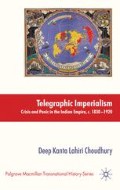Abstract
The period 1905–10 has been so far conventionally accepted as the Swadeshi and Boycott period and the first phase of revolutionary extremism, while it sometimes figures as a period constituting a prehistory of labour movements, popular politics, and communalism. This chapter investigates the relatively less studied telegraph strike of 1908. This strike occurred simultaneously in Rangoon, Moulmein, Calcutta, Allahabad, Agra, Bombay and Karachi. Both telegraph signallers and subordinate staff went on strike in these places. The strike was underway when the first revolutionary extremists were arrested in Calcutta. The entire focus of the government and the India Office in London was on this anarchist threat. Through a study of the information panic that ensued, this chapter examines these two events to argue for particular, though not necessarily co-ordinated, investments by different sections of the state and media in the construction of a narrative of events.
Access this chapter
Tax calculation will be finalised at checkout
Purchases are for personal use only
Preview
Unable to display preview. Download preview PDF.
Notes
Work has been done on the railways for example, I.J. Kerr, who looks at the labour employed in constructing the railways; Building the Railways of the Raj 1850–1900 Delhi: Oxford University Press, 1997.
For example, G.K. Sharma, Labour Movement in India Delhi: People’s Publishing House, 1971
Panchan Saha, Bangla Sramik Andoloner Itihas Calcutta: Mukti Publishers, 1972, pp. 12–15
S. Sarkar, The Swadeshi Movement in Bengal 1903–1908 Delhi: People’s Publishing House, 1973.
The argument regarding community consciousness, as opposed to class-consciousness, is made by D. Chakrabarty, see ‘Communal Riots and Labour: Bengal’s Jute Mill-Hands in the 1890s’, Past and Present 91, May 1981, pp. 140–69. For a critique see S. Basu, ‘Strikes and “Communal” Riots in Calcutta in the 1890s: Industrial Workers, Bhadralok Nationalist Leadership and the Colonial State’, Modern Asian Studies 1998, vol. 34, no. 4, pp. 949–83.
Elizabeth J. Perry, ‘From Paris to the Paris of the East and Back: Workers as Citizens in Modern Shanghai’, Comparative studies in Society and History vol. 41, no. 2, April 1999, pp. 348–73.
Cf. T.H. Marshall, Citizenship and Social Class Cambridge: Cambridge University Press, 1950.
G.D.H. COLE, The World of Labour: A Discussion of the Present and Future of Trade Unionism London: G. Bell and Sons, 1913, pp. 193–204.
See S.K. Sen, Working Class Movements in India 1885–1975 Delhi: Oxford University Press, 1993, Chapter II, ‘Nationalist movement and the rise of the working class 1885–1919’, pp. 23–38, passim Sukomal Sen, Working Class of India: History of Emergence and Movement 1830–1970 Calcutta: K.P. Bagchi, 1977; I.M. Reisner and N.M. Goldberg (eds), Tilak and the Struggle for Indian Freedom Delhi: People’s Publishing House, 1966.
Bryna Goodman, City and Nation: Regional Networks and Identities in Shanghai 1833–1937 Berkeley: University of California Press, 1989
R. Chandavarkar, The Origins of Industrial Capitalism in India: Business Strategies and the Working Classes in Bombay 1900–40, Cambridge: Cambridge University Press, 1994.
Henry Peiling, A History of British Trade Unionism London: Macmillan, 1976 (first edn 1963), pp. 126–7.
D.K. Lahiri Choudhury, ‘India’s First Virtual Community and the Telegraph General Strike of 1908’, International Review of Social History 48(2003), Supplement, pp. 45–71.
Author information
Authors and Affiliations
Copyright information
© 2010 Deep Kanta Lahiri Choudhury
About this chapter
Cite this chapter
Choudhury, D.K.L. (2010). The Telegraph General Strike of 1908. In: Telegraphic Imperialism. The Palgrave Macmillan Transnational History Series. Palgrave Macmillan, London. https://doi.org/10.1057/9780230289604_8
Download citation
DOI: https://doi.org/10.1057/9780230289604_8
Publisher Name: Palgrave Macmillan, London
Print ISBN: 978-1-349-30171-3
Online ISBN: 978-0-230-28960-4
eBook Packages: Palgrave History CollectionHistory (R0)

